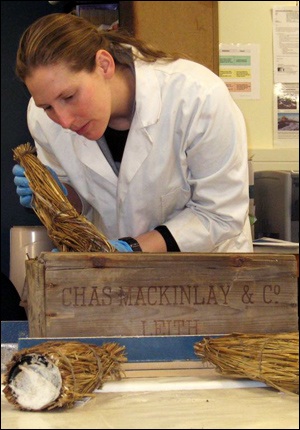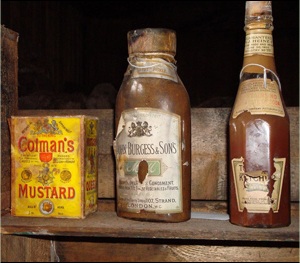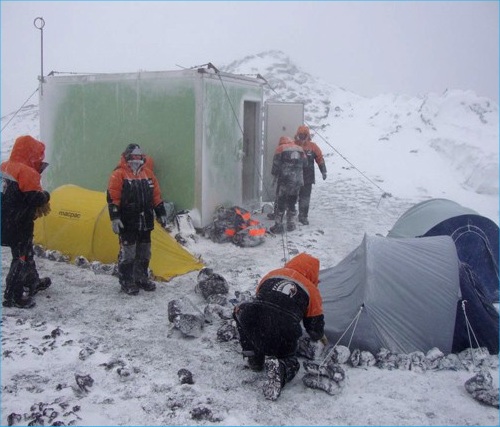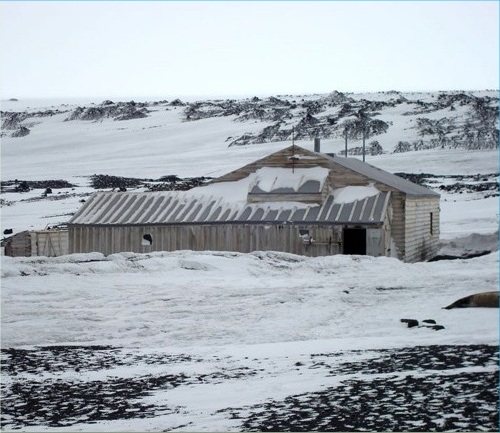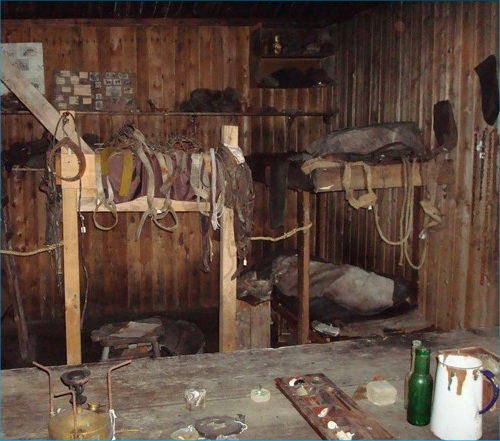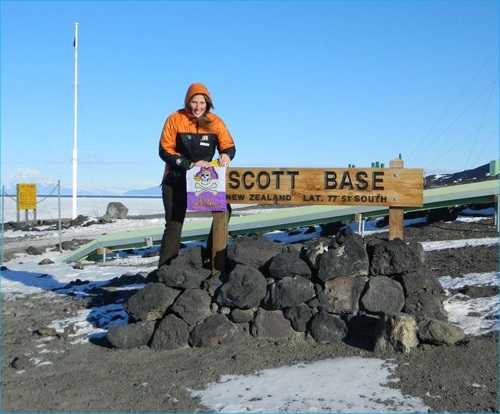Publisher's note: This article, by Jeannine Manning Hutson, was originally published in ECU News Services.
ECU conservation director preserves artifacts in Antarctica
An East Carolina University faculty member has had a once-in-a-lifetime experience - again.
Susanne Grieve, director of conservation at ECU, lived and worked in Antarctica for eight months in 2012 through the Antarctic Heritage Trust, a non-profit organization based in New Zealand. The trust is responsible for the preservation of four expedition bases on Antarctica that were funded by the British Antarctic Society.
Grieve first went to Antarctica
Grieve works to conserve a wooden box, an artifact from Robert F. Scott’s hut at Cape Evans, Antarctica.
(Photo courtesy: Antarctic Heritage Trust)
in 2008 after seeing a posting on a discussion list for conservators. "It changed my life in every way," she said. That experience, working as a conservator, led to her coming to ECU to begin teaching.
"And like anything in life, you have to apply to have the opportunity," she said. She had to reapply for the 2012 trip. "I think because I had wintered there previously and I knew a little bit about the living conditions and psychologically what it's like, they brought me back as a lead conservator."
Grieve, who specializes in object conservation, led a team of three other conservators, including a book and paper specialist.
From January to late August 2012, Grieve and her team worked through Antarctica's winter to preserve the contents of Cape Evans, the historic hut built and occupied from 1910-13 by the crew of Capt. Robert Falcon Scott, who is most famous for his race to the South Pole.
On Jan. 17, 1912, Scott and four of his men reached the South Pole only to find that Roald Amundsen of Norway had beaten them there by four weeks. Scott and his crew began the journey back to their camp; none of them survived. A search party found Scott's diary and three men's bodies eight months after they had died on March 29, 1912 from starvation and exposure in their tent.
Scott's wooden hut,
The Scott expedition crew brought comforts from home such as mustard and ketchup. (Photo courtesy: Antarctic Heritage Trust)
which is at risk from damage due to snow build-up and other environmental factors, contains more than 8,000 artifacts, according to Antarctic Heritage Trust.
The trust works to preserve structures and artifacts left by explorers during the early 20th century.
"Because the weather is so aggressive in the winter, we couldn't work outside at the huts. We used the modern government facility run by New Zealand, Scott Base, to treat the objects," she said.
Scott Base hosted a crew of 14 last winter, 10 of whom are base maintenance staff who keep everything running. "You don't meet these people until the day you arrive at the base, so you have to be open to different personalities and conflict resolution. This whole experience is about going outside your comfort zone and learning how to develop yourself," Grieve said.
Also on Antarctica is the larger McMurdo Base, which has a winter population of about 250, growing to approximately 1,200 in the summer. The residents of Scott Base often travel the four kilometers (about 2.5 miles) over to McMurdo for entertainment or to visit the hydroponic greenhouse there for some Vitamin D therapy from the lights, Grieve said.
Grieve and
During one of Grieve's trips to Robert F. Scott's hut, the weather worsened to conditions that didn't allow the helicopter to return to pick the team up for two days. They had to put their field training to the test. (Contributed photo)
her conservation team focused on treating the "iconic artifacts" of the Scott expedition structures, including harnesses that the men wore to pull equipment around and a pillow that famous Scott exploration team member Apsley Cherry-Garrard used.
"It was really cool for me because this was an object that had provided him so much comfort and you could see the halo of where his head had been," she said.
Grieve and her team treated 1,300 artifacts during their seven-month season. "In the United States, that's unheard of. You might treat an artifact every two weeks. But it has to be done because of the finite resources," she said.
They also
This is the hut built and used by explorer Robert F. Scott and his crew at Cape Evans. Grieve worked to conserve artifacts found there. (Photo courtesy: Antarctic Heritage Trust)
worked on clothing and shoes left by the explorers. And letters and Christmas cards were in the hut that the men on the expedition team received during their time on Antarctica.
"Many times they left behind things that they didn't need on the return journey, and they had stayed there for two years. Often the relief ships would arrive and they would have to quickly leave the huts," she said.
The Antarctic Heritage Trust focuses on preserving the huts to reflect that first occupation by Scott's men, even though others used the huts after Scott's ill-fated trek to the South Pole in 1912.
"Preserving these
The interior of the hut used by Robert F. Scott and his crew is shown in his photo. (Photo courtesy: Antarctic Heritage Trust)
huts is completely a balance between the natural preservation and the historical preservation. You have to make sure the animals are protected because they nest in the hut areas but you try to preserve that history," she said. On Ross Island, Grieve saw Emperor and Adélie penguins and seals.
Because all the materials had to be brought over by ship, the explorers' huts were prefabricated in England and Australia. "And they man-hauled all the equipment up on shore. (The crews) had no idea what to expect there because it was such an unexplored territory," she said.
Darkness for months
"While I was down there, it was dark for four months, 24 hours of darkness. No hint of a sunrise or sunset and your body notices that. No flights in or out. No fresh fruits or vegetables. No mail. We did have contact through satellite connections, but you are isolated," Grieve said.
The team worked six days a week to have a set schedule, but they did have some fun, she said. Team members were able to explore the area outside and work on personal projects such as knitting and painting and "there is a bar so a lot of socialization revolved around the bar," she said, laughing.
The base
East Carolina University faculty member Susanne Grieve proudly displays an ECU flag at Scott Base in Antarctica. (Contributed photo)
has a no interference policy - everything that is brought to the continent is later carried off. Everything is carefully protected even food and human waste so it doesn't adversely affect the environment, she said.
Because of the strict environmental regulations, the conservators couldn't bring certain solvents and chemicals. "For me it was professionally challenging because I couldn't work with the materials I was used to working with at a museum," she said.
And the temperature was another obvious hurdle.
The average temperature while Grieve was at Antarctica was -35 degrees Celsius or -31 degrees Fahrenheit, ambient. With the wind, it can feel like -100 C or -148 F.
With the proper equipment, Grieve could work outside for about two hours at -35 C. She could only stay out about 10 minutes at -100 C. "It's not possible to survive at such extreme temperatures. This is a continent that doesn't want humans on it. We're just not that well adapted to live there," she said.
Even though researchers and visitors are instructed when they leave not to take anything from Antarctica as a souvenir or memento of their time there, Grieve did come home with something special - a fiancé.
During her months on Antarctica, she met and fell in love with a fellow Scott base resident, Jeff Rawson of New Zealand, who was there as a maintenance engineer and on the search and rescue team.
After Grieve left Antarctica, Rawson headed out to Roosevelt Island to live in a tent for several months working with a crew performing deep ice core drilling experiments.
She admitted it was an "accelerated courtship" because they were together - along with the other Scott Base residents - 24 hours a day for seven months.
Rawson will soon make his first trip to the United States, moving to Greenville when he and Grieve marry in the spring and begin their next adventure together.
Grieve said she plans to use her experiences in Antarctica to encourage her students to dream big.
"I never imagined in my life that I'd go to Antarctica to do conservation," she said.
"I think it demonstrates that if you're passionate about something then there are no boundaries."
To see a video of Robert F. Scott's hut visit:
http://www.nhm.ac.uk/nature-online/earth/antarctica/antarctic-conservation/index.html
To read blog entries by Grieve and other conservators from working on Scott's hut, visit the Antarctic conservation section of the Natural History Museum of London's website:
http://www.nhm.ac.uk/natureplus/community/antarctic-conservation?view=blog#/
For more information on the work being done by the Antarctic Heritage Trust visit:
http://www.nzaht.org

